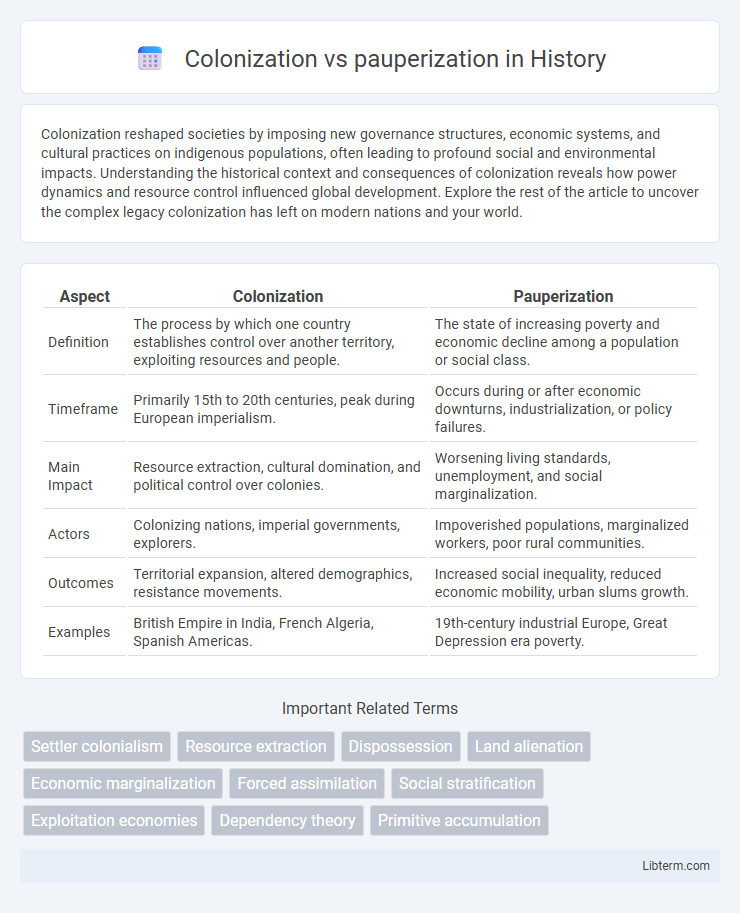Colonization reshaped societies by imposing new governance structures, economic systems, and cultural practices on indigenous populations, often leading to profound social and environmental impacts. Understanding the historical context and consequences of colonization reveals how power dynamics and resource control influenced global development. Explore the rest of the article to uncover the complex legacy colonization has left on modern nations and your world.
Table of Comparison
| Aspect | Colonization | Pauperization |
|---|---|---|
| Definition | The process by which one country establishes control over another territory, exploiting resources and people. | The state of increasing poverty and economic decline among a population or social class. |
| Timeframe | Primarily 15th to 20th centuries, peak during European imperialism. | Occurs during or after economic downturns, industrialization, or policy failures. |
| Main Impact | Resource extraction, cultural domination, and political control over colonies. | Worsening living standards, unemployment, and social marginalization. |
| Actors | Colonizing nations, imperial governments, explorers. | Impoverished populations, marginalized workers, poor rural communities. |
| Outcomes | Territorial expansion, altered demographics, resistance movements. | Increased social inequality, reduced economic mobility, urban slums growth. |
| Examples | British Empire in India, French Algeria, Spanish Americas. | 19th-century industrial Europe, Great Depression era poverty. |
Understanding Colonization: Definition and Historical Context
Colonization refers to the process by which a powerful country establishes control over a less powerful region, often exploiting its resources and indigenous populations for economic and political gain. Historically, European colonization during the 15th to 20th centuries reshaped global demographics, cultures, and economies through territorial conquest, settlement, and resource extraction. This process frequently triggered pauperization, a condition of widespread poverty and social decline among colonized peoples, due to displacement, resource depletion, and economic marginalization.
Pauperization Explained: Causes and Consequences
Pauperization refers to the process of becoming impoverished or experiencing a decline in economic status, often driven by factors like colonization, unequal resource distribution, and systemic exploitation. The consequences include widespread poverty, reduced access to education and healthcare, and the erosion of social structures, which perpetuate cycles of deprivation. Key causes involve displacement of local populations, extraction of wealth by colonial powers, and disruption of indigenous economies, leading to long-term socioeconomic instability.
Key Differences Between Colonization and Pauperization
Colonization involves the establishment of control by one nation over another territory, often exploiting resources and indigenous populations for economic and political gain, whereas pauperization refers to the process of impoverishment and decline in living standards among a population. Colonization typically results in structural changes, such as altered governance and economic systems favoring the colonizer, while pauperization manifests as increased poverty, unemployment, and reduced access to basic needs. The key difference lies in colonization being an imposed external domination process, whereas pauperization focuses on the internal socioeconomic deterioration of a marginalized group.
Historical Examples: Colonization vs Pauperization
Historical examples of colonization reveal a pattern where imperial powers extract resources and impose control on indigenous populations, often leading to widespread pauperization. In Africa, European colonization disrupted local economies and social structures, resulting in poverty and underdevelopment that persisted long after independence. Similarly, the colonization of Latin America by Spain and Portugal enriched the colonizers while causing significant pauperization among native communities through forced labor and land dispossession.
Economic Impact: Wealth Extraction vs Resource Depletion
Colonization frequently entailed systematic wealth extraction from indigenous economies, funneling natural resources and labor to imperial powers, resulting in significant capital accumulation for colonizers at the expense of local development. Pauperization followed as resource depletion and economic exploitation dismantled indigenous industries, undermining sustainable growth and perpetuating poverty in colonized regions. The economic impact is evident in diminished GDP, depleted natural capital, and entrenched inequality, highlighting the long-term consequences of colonial resource policies.
Social Structures: Oppression, Displacement, and Poverty
Colonization fundamentally reshaped social structures by imposing oppressive hierarchies that displaced indigenous populations and dismantled traditional community organizations. The forced displacement resulted in widespread pauperization, as native peoples lost access to land, resources, and economic opportunities essential for their survival. These intertwined processes entrenched systemic poverty and social marginalization, perpetuating inequality long after colonial rule ended.
Long-term Effects on Indigenous Populations
Colonization often led to the pauperization of indigenous populations by stripping them of ancestral lands, disrupting their traditional economies, and imposing exploitative labor systems that entrenched poverty. The long-term effects include intergenerational economic disadvantages, loss of cultural identity, and systemic marginalization within national frameworks. These enduring impacts contribute to persistent social inequalities and hinder efforts toward indigenous empowerment and self-determination.
The Role of Policies in Colonization and Pauperization
Policies during colonization often enforced economic structures that extracted resources and labor, directly contributing to pauperization in colonized regions. Land dispossession laws, forced labor regulations, and trade restrictions imposed by colonial administrations systematically undermined indigenous economies and entrenched poverty. These policies created lasting socio-economic disparities, perpetuating cycles of deprivation even after formal colonial rule ended.
Modern Parallels: Neo-colonialism and Global Inequality
Neo-colonialism perpetuates economic dependency and exploitation reminiscent of traditional colonization, exacerbating global inequality by transferring wealth from impoverished nations to wealthy powers. Modern multinational corporations and international financial institutions often enforce structural adjustments that deepen pauperization in developing countries. This dynamic sustains socio-economic disparities by limiting local autonomy and stifling sustainable development in historically marginalized regions.
Paths to Recovery: Resistance, Reparations, and Empowerment
Paths to recovery from colonization-induced pauperization emphasize community-driven resistance, demanding reparations to address economic disparities, and fostering empowerment through education and self-governance. Grassroots movements and indigenous activism play crucial roles in reclaiming cultural identity and economic autonomy. Implementing reparations involves both financial compensation and structural reforms to dismantle systemic inequalities rooted in colonial oppression.
Colonization Infographic

 libterm.com
libterm.com